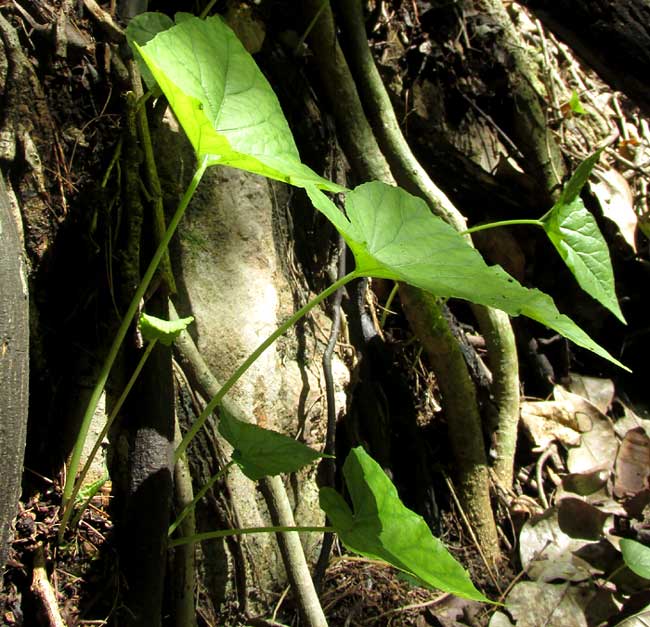Excerpts from Jim Conrad's
Naturalist Newsletter
from the July 3, 2016 Newsletter issued from Hacienda Chichen Resort beside Chichén Itzá Ruins, central Yucatán MÉXICO
SNAKEWORT

Back in the 1970s when I served as naturalist on Maya-ruin-visiting treks through the then-heavily forested Petén region of northern Guatemala, one of the first plants I learned was an ankle-high herb that seemed to be missing in most of the forest understory, but always turned up as we approached Maya ruins. Then all over the ruin mounds and nearby, the herb's arrowhead-shaped leaves could be seen in abundance. We learned to look for ruins by spotting the plant. The local baggage carriers knew the plant well, for it was highly esteemed as a powerful medicinal plant with several uses. It was DORSTENIA CONTRAJERVA, sometimes in English called Snakewort, a member of the Fig Family, the Moraceae.
On the rocky sides of the deeply shaded, humid, jungly, rejollada-type sinkhole on the Hacienda's grounds, the same plant is conspicuously appearing now, which well it might because it's surrounded by the ruins of Chichén Itzá. A few minutes' walk away from the Hacienda and the ruins, the plants disappear. At the top of this page you can see one rooted on the Hacienda sinkhole's limestone wall.
When wildflower fanciers familiar with typical flower structure see this herb's flowers, they're astonished. In the above picture the flowering structure is in plain view, looking like a malformed leaf on a stem, or peduncle, half as long as the longer leaf petioles. The structure looks like a green, flat disc with irregularly crinkled margins, bent down at the top. See it? A close-up of it is shown below:

Notice the tiny, slender, short, hair-like items arising from the object's inside face. Those are two-branched styles arising atop ovaries. Therefore, the face of the green, bent-object in the picture is entirely covered with tiny ovaries, which later will mature into minuscule, one-seeded, drupe-type fruits scattered across the object's surface. The "object" is a "receptacle," with the ovaries partly embedded in it. The receptacle's other side, where the peduncle connects, bears no flowers. I read that when the drupes mature, their seeds are expelled explosively.
Sense can be made from the above picture by remembering that Snakewort is a member of the Fig Family. Visualize a fig "fruit", which actually is a specialized structure known as a synconium, formed like a spherical urn with a very small mouth, and with tiny flowers covering its INNER surface -- so that the flowers cover the sphere's inside walls. Visualize opening up the synconium by forcing its mouth open more and more, until the synconium no longer is spherical with flowers inside it, but rather a flattish sheet with flowers on one side of it. That's our Snakewort's fruiting structure. It's like an opened-up fig synconium.
In 1753 when Linnaeus himself gave Snakewort its botanical name, his species name "contrajerva" was the Latinized form of the plant's Spanish name, "contrahierba," normally applied to plants used for treating poisoning and snakebite. The online Biblioteca Digital de la Medicina Tradicional Meicana reports that in the Yucatan, for snakebite, an infusion of Snakewort is sweetened with honey, then taken every hour or two, depending on the bite's severity. Also, the roots and leaves can be cooked with other plants and taken not only for snakebite but also against the bite of mad dogs, and food poisoning.
Other uses practiced here and there include being administered for toothache, dysentery, stomach ache, bad digestion, gynecological problems, as an aid in giving birth, to cause wounds to close, for coughs, diabetes, lack of appetite, for malaria, and more.
In other words, Snakewort is used for so many cures that one wonders whether any of them work. After reporting the above uses and many more, the Biblioteca Digital sums up matters by saying that experimental studies have failed to corroborate any of these claims.
So, the general scientific consensus is that Snakewort isn't of much or any medicinal value, despite its long history as such.
I think I understand how Snakewort gained its reputation. As I said earlier, anyone familiar with typical flower structure is bound to be mystified when they see this herb's unusual flowers. Traditional herb doctors and curanderos throughout the centuries certainly were familiar with the flowers of many plants, and to them Snakeworts flowers must have seemed so otherworldly that they just had to assume that it must possess special features. Especially it could be easy to become known as an antidote to snakebite, since country folks swear that nearly every snake is poisonous, though only a relative handful are. Being bitten by a ratsnake or gartersnake can be "cured" with dandelion leaves.
Snakewort occurs naturally from southern Mexico to northern South America, but it's abundantly cultivated "for its medicinal uses" in Indonesia and Malaysia, and locally in Africa and South America. It's a weed in greenhouses and nurseries, and in Florida it's been introduced.